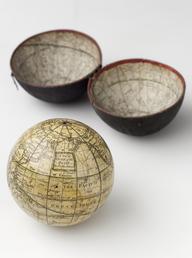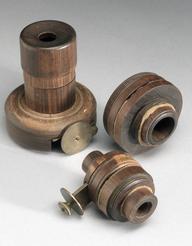

Brass sextant with gyroscopic artificial horizon and case.
Brass sextant with black lacquered frame, polished brass limb, wooden handle and fitted with gyroscopic artificial horizon invented by French Admiral Fleuriais, and made by Hurlimann, Ponthus and Therrode, Paris, France, 1910-19. Consists of inlaid polished silver 126° scale (-5° to 107°) with 20’ divisions and silver vernier (30”), three index-filter shades (red, green & orange), two horizon filters (orange), scale magnifier on 70mm swivelling arm. Fitted with threaded telescope bracket for sighting telescope (191mm – upright image). Supplied with horizon light, magnifier, adjusting key and other accessories with circular brass box and mahogany case with manuscript instructions. The artificial horizon consists of an airtight housing containing a gyroscope that can be locked with a lever mechanism. The gyroscope has a glass piece through the body, with a series of horizontal lines, and is propelled by an air pump. The air gauge is calibrated from 0 to 76 cm of mercury.
Details
- Category:
- Astronomy
- Object Number:
- 1929-444
- credit:
- British Admiralty (Hydrographic Department)




